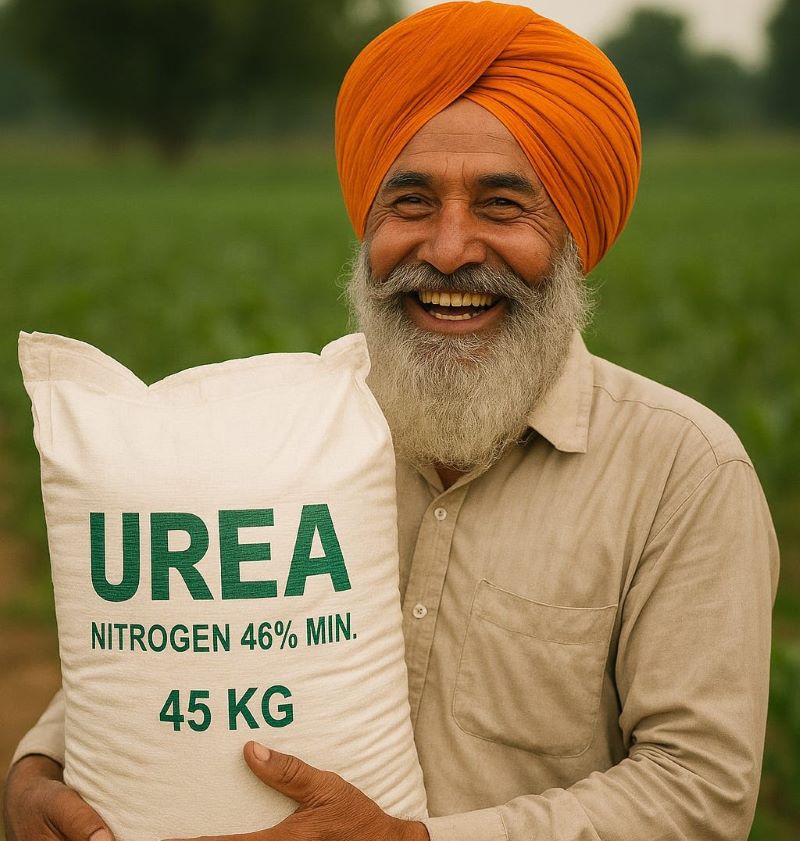 In Punjab’s farm towns this kharif, the urea debate isn’t abstract. It’s happening at the counter—where private dealers nudge farmers to “take a pesticide or bio-stimulant with every bag,” while many Primary Agricultural Cooperative Societies (PACS) complain their racks stay thin. The result is a predictable spiral: panic buying, rationing, black-marketing, and farmers caught between a state that says “stocks are adequate,” a Centre that says “availability is comfortable,” and a pipeline whose incentives are plainly distorted.
In Punjab’s farm towns this kharif, the urea debate isn’t abstract. It’s happening at the counter—where private dealers nudge farmers to “take a pesticide or bio-stimulant with every bag,” while many Primary Agricultural Cooperative Societies (PACS) complain their racks stay thin. The result is a predictable spiral: panic buying, rationing, black-marketing, and farmers caught between a state that says “stocks are adequate,” a Centre that says “availability is comfortable,” and a pipeline whose incentives are plainly distorted.
Punjab’s Agriculture Department says there’s no shortage: kharif requirement ≈14.5 LMT of urea, ≈16 LMT received, ≈14.7 LMT sold—balance with dealers. That tally, however, sits alongside the Department’s state-wide inspection drive—checks at 2,324 retailers across all 23 districts—launched after a spike in sales at certain outlets and allegations of diversion to industry. Farmers’ panic purchases and reports of over-MRP sales add to the tension.
Private vs PACS: who gets the bag—and at what hidden cost?
Two frictions define the market right now:
1. Bundling / “forced tagging”
Dealers and wholesalers in Punjab have repeatedly alleged that companies tag non-subsidised products (nano fertilisers, pesticides, additives) with urea/DAP. In July 2025, the Union Fertilisers Ministry formally warned companies against this malpractice under the Essential Commodities Act/FCO, after complaints from multiple states. Even so, the practice persists enough for farmers to feel it at the counter.
2. Allocation asymmetries & last-mile access
The state’s cooperative arm (Markfed/PACS) is central to public distribution—Markfed even tendered large volumes of urea for kharif delivery to societies statewide. Yet earlier seasons showed uneven shares and farmer complaints: reports noted private dealers handling a big slice of urea sales while PACS struggled with timely supply; others accused private outlets of tagging extras with DAP. Net effect: where PACS are thin on the ground or understocked, private counters dominate—and set the rules of engagement.
New Delhi’s recent updates say national availability is “comfortable” this season (urea availability ≈183 LMT vs pro-rata 143 LMT; sales already high). The Department of Fertilisers also highlights a sharp jump in urea sales year-on-year—framing local scarcities as distribution/diversion problems, not aggregate supply. Punjab counters with its “16 LMT received” ledger while acknowledging enforcement against misuse. Both can be true: enough nationally, tight locally—especially when an early monsoon synchronises top-dressing windows and the pipeline is leaky.

A farmer and keen observer of current affairs
At the root sits a policy choice: the statutory MRP of urea is a fraction of its economic cost (currently ₹242/45-kg or ₹268/50-kg, taxes/neem-coating extra). That underpricing widens the spread with other nutrients, spurs over-demand and hoarding, and makes smuggling/diversion lucrative—whether to industry or across borders. When whispers of “premium” sales emerge in Punjab districts, they are symptoms of this deeper distortion.
As queues lengthen, the blame game intensifies. Opposition leaders—Pargat Singh prominent among them—allege subsidised urea is being diverted to corporate houses while farmers are scapegoated. The government replies with inspections and paper stock numbers. Meanwhile, farmers see dealers pushing add-ons and PACS with thin shelves. Politics thrives; confidence erodes.
From the Red Fort this August, PM Narendra Modi pitched fertiliser self-reliance—revived plants, lower import dependence, and judicious use (including nano options). It’s a long-term correction that Punjab should welcome. But farmers don’t sow slogans; they sow on time. Unless pricing is rationalised, tagging is stamped out, and district-level transparency improves, the Centre’s macro-comfort and Punjab’s paper-comfort won’t prevent micro-shortages at exactly the week nitrogen is due.
Publish a daily, district-wise “fertiliser dashboard.” Show rake arrivals, PACS vs private stocks, and expected replenishments so farmers know where to go and when—and rumours don’t run the market.
Zero tolerance on tagging. Enforce the Union’s July directive with joint state-DoF squads; name violators (companies or outlets). Make one high-profile case stick to deter the rest.
Balance the last mile. Where PACS density is low or understocked, temporary re-balancing toward the nearest reliable channel (even private) with price-enforcement teams on site is better than empty racks. (And vice-versa where private outlets are the problem.) Evidence from previous seasons shows mis-allocation fuels the queue, not the ledger.
Target diversion to industry. Track bulk buyers via PoS/mFMS and reconcile with industrial consumption; surprise audits at hot-spot districts. The Indian Express’ recent report on industrial diversion in Punjab should be treated as a trigger for prosecutions, not press notes.
Keep agronomy front-and-centre. Push PAU-aligned nitrogen schedules and low-N paddy varieties; when top-dressing is balanced, panic demand softens. (A pricing reform at the Centre—moving urea toward NBS—would turbocharge this, but the state can still scale advisories.)
Urea scarcity in Punjab is not a simple story of “Centre undersupplies” or “state mismanages.” It’s a man-made scarcity produced by skewed prices, uneven last-mile allocation between private dealers and PACS, and a bundling culture that exploits the subsidy regime. Everyone has a statement; farmers have a queue. Until tagging is crushed, stocks are published in real time, and PACS–private flows are balanced to the village, the sufferers will remain the farmers.